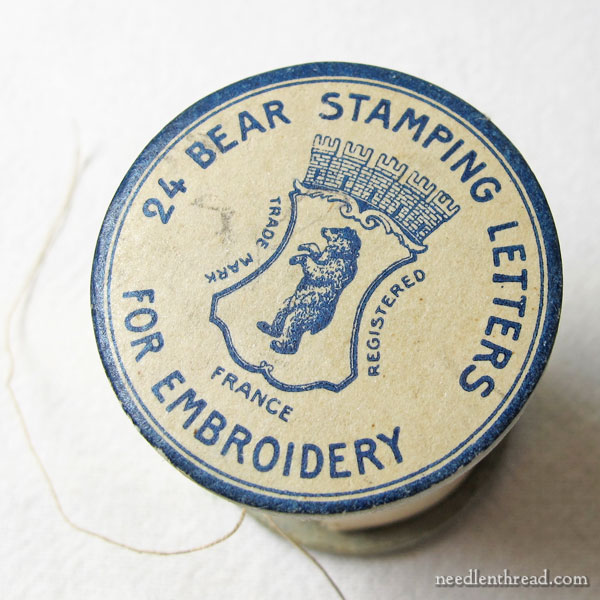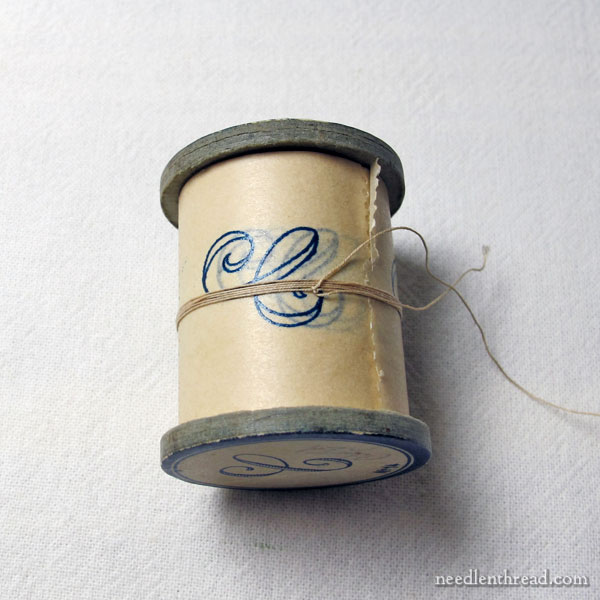During the Victorian age and up into the first part of the 20th century, single initials, monograms or ciphers (there’s a difference between initials, monograms, and ciphers, explained here) embroidered onto personal linens served more than just a decorative purpose. And sometimes, they were so simple, small, and discreet that they weren’t necessarily even that decorative.
Imagine marking all the personal linens in your trousseau. (Um…ok, first imagine that you had to have a trousseau…).
Every hanky, every under garment…just so there’d be no mix up in your household laundry when your servants or your laundry service cleaned them.
Imagine that your husband or brother or father is going off to fight in WWI, and his personal linens all need to be marked. It’s not as if you can whip out the Sharpie, after all.
Or just imagine that you’re an industrious embroiderer who wants to embroider a neat little initial on a nice pile of hankies to to sell, to give as a gift, or whatever.
Wouldn’t it be nice if you could impress the letter’s design onto many different linens, uniformly?
Enter, the iron-on transfer, first developed in the late 1800’s, and popular ever since for the easy transfer of embroidery patterns.
How happily handy!

I love vintage embroidery transfers! And I especially love unique embroidery transfers that you don’t see every day.
When this darling little spool of embroidery transfers fell from an envelope into my hand (thank you, Jane!), I just fell in love with it.
My imagination flew immediately to all those women in the past who chose to, or had to, mark linens. And I just bet that, when heat transfer stamping patterns came about – and when little initials like these became available – they were pretty happy customers!

This little spool holds a strip of 24 little perforated stamps of the initial C, all exactly the same. Each little stamp can be torn from the strip, and with the simple application of the iron, you have your transfer, nice and neat and ready to stitch.

The original Bear Stamping Patterns like this came on a spool which fit into a little round box or card-like wrapping, sealed with wax. This particular spool has been opened at one point and some of the letters (or at least one) have been used.
This is such a nice little piece of embroidery history!
The spool cost about 2 cents back in the day, by the way.
So, just a fun little embroidery item from the past. I hope you enjoy seeing it!
One thing I realize whenever I see pieces like this is that the question of how to easily transfer embroidery designs isn’t a new one. It’s been pondered and tackled in different ways in every century.
Further Reading about Monograms
If you like monograms, you might enjoy reading this article, A Brief and Selective History of Monograms. At the end of the article, there are some further links worth pursuing as well.







Fascinating! Thanks for sharing, Mary.
Dear Mary
Oh what a lovely vintage stamp and a great monogram transfer idea, I bet this labour saving item was revolutionary when it came on the market in the late 19th century. A lovely gift for you Mary and a nice surprise I bet you were delighted. Yes as you say transfer of embroidery is a never ending quest. Thanks for sharing your vintage monogram transfer stamp with us and for the history of monograms.
Regards Anita Simmance
Ohhhh…that spool of transfers is wonderful! I am especially drawn to it because my last name starts with “C” ! 🙂
I have never seen a spool of transfers before-thanks for sharing-will keep my eyes peeled as spring brings on the flea market treasure hunting season!
I have a large selection of rubber stamps. Some of them are quite simple letters, some are stylized whimsical animals, some are art deco. I have used them all for embroidery by wetting them with blueing and then stamping them on fabric. Works quite well!
Hi Suzanne, would you please explain more about “wetting them with blueing”? I tried to Google search but to no avail! Thanks in advance.
There is a laundry product called bluing to make whites whiter. I never would have thought to use with rubber stamps for embroidery. I’d love more details also!
Hi, Gail – I’m not sure that it’s the same stuff. I think this is more of an ink, than a cleaner. I don’t know that blueing (for laundry) would work well for stamping a pattern. They sell a blue pounce powder, and I wonder if it can’t be mixed with alcohol or something similar, to make an ink-like concoction that can be washed away. It would be interesting to experiment!
Jennifer and JustGail:
This is where you can learn about the product:
http://mrsstewart.com/where-to-find-msb/
I did this mainly for children’s clothing, pillowcases, etc. Make a small pad with Kleenex, put it in a protective container, squirt some liquid blueing on it (in the range of “not too much-not too little” it will soon be obvious) proceed as though you are doing regular stamping. Let it dry and then stitch. Not the quality of The Secret Garden, but delightful and small.
Thanks, Suzanne! That’s great information. So it is laundry blueing! I’m going to try it!
Thank you Suzanne
Do you have any idea of what type of ink they used on the older transfers? Or how there were produced so each letter was exactly the same?
I did use the link you gave to initials, ciphers and monograms. I think I like the initials the best. I never did figure out the letters on the monograms. The first monogram you shared you said there were 3 letters interwoven but I could only make out 2, even out of all the 6 examples you gave. My eyes are worse than I though. 🙂
How about that! You learn something new everyday.
So interesting. Thank you so much for the bit of history. I just love history of any sort, and these “little bits” are the most truly interesting and the ones that seem to slip thru the cracks and get lost. They are the true “people’s lives” stories that we generally don’t get to see. It’s always about the “big” issues, when reality is the everyday stuff was what people really lived. Love this post.
I love them!
There is, however, something unbelievably poignant about sending someone off to the trenches with little hand embroidered monograms on their things.
I like the trousseau idea much better. (If only one had had such a thing.) I should monogram the sheets though, better late than never.
I never see the little spool for monograms. Thank you Marie.
What a lovely little bit of history. I had never seen or heard of those rolls of transfers. Thanks for sharing that “bit”
Thank you so much for showing this lovely piece of embroidery equipment! By the way, I can pick up the Millie Marotta book from the bookstore tomorrow. I’ve just laundered an off-cut of a beautiful white silk damast with a paisley pattern. And I’ve picked out some lovely autumn coloured perle #12’s from House of Embroidery. I can’t wait to start on the curled up fox. Thank you so much for drawing my attention to it! Love, Jessica
I can’t wait to see the fox, Jessica!!
I love this idea thank mary for sharing it!!!
Love, love, love these and it is ‘C’ for Coral-seas and ‘C’ for Carol (Coral) and ‘C’ for Conway (CC = c’s = seas). These have my name written all over them!
🙂
Hello ladies,
I remember this ‘Blue’ for the laundry; they were just referred to as ‘the blue bag’.
It was a hard piece of dark blue ? tied up in a small piece of square white cloth. It was swished around in the washing water to make whites extra white. I think it was like those ‘blue beads’ that we can see in some of our washing powders today. It really did make the whites really white.
It was also always used for removing the pain out of bee or wasp stings. Then again, perhaps it was that ‘blue’ medal of honour that was what reduced the sting! 🙂
It would easily wash out as soon as the article was washed after embroidering, so it wouldn’t have caused harm to anything.
Cheers,
Wendy M.
Thank you Wendy. Can someone explain how to use the ‘Blue’ to transfer a design onto fabric? Thanks in advance.